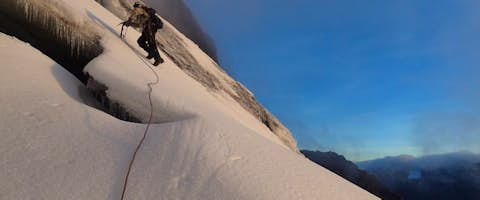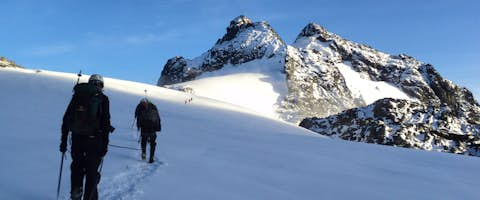Flora in the Rwenzori Mountains
Aside from the high alpine views, it is the flora of the mountains that has a far greater impact on the visitor than the local fauna.
Water is everywhere - cloud-bound, heavy in the mist, filling mountain streams and making mirrors of lakes.
Temperature below 4,000 metres rarely exceeds 15 degrees Celsius and stays above freezing. This means that life thrives and the plants are dramatic.
The lobelia are massive; heather stretches across the valleys; while garishly-coloured moss creeps across gnarled trees draped with lichen.

Jungle, grassland, or snow-capped peak? Rwenzori is all three.
Explore the Rwenzori Mountains
Below are a few examples of how the Rwenzoris can feature in your Ugandan adventure. These trips can be booked directly, adjusted to suit you, or we can start with a blank sheet of paper and build a completely tailor-made itinerary.
A trek will take you through different altitudinal zones of vegetation, each with its own micro-climate, flora and fauna.
The Afro-montane forest covers the slopes between 1,800m and 2,500m and has the most variety. Large established trees push to establish a canopy, whose breaks are filled by dense thickets.
From 2,500m to 3,000m dense forest gives way to bamboo stands, leaves covering the ground in a dense litter and the flowers emerging only once every 30 years.
Above this, until 4,000m, you enter the heather zone. Sphagnum moss and usnea beard lichens pervade and the ground is stabbed with coral pink orchids. Bog-wet valley bottoms are populated by large tussocks.
Above 4,000m the alpine zone hosts giant groundsel, Senecio adnivalis and the torch lobelia, Lobelia wollastonii.
After 4,300m the vegetation begins to thin out until nothing grows except moss, lichen and a few ‘Everlasting’ plants. The plants found above 3,800m are members of some of the world’s rarest botanical communities.

Fauna in the Rwenzori Mountains
These vegetation zones are home to 70 species of mammal and 177 bird species. Of the mammals, there are elephants, chimpanzees, Rwenzori otters and leopards. Although present, the dense forest means these are seldom seen.
Primates such as colobus (Angola and black-and-white varieties are both thought to be present) and blue monkeys are easier to spot, as are small antelope such as bushbucks and unusual reptiles such as the three-horned chameleon.
Of the bird species present, several are Albertine Rift endemics which makes the Rwenzoris an Important Birding Area (IBA).
The greatest diversity is found in the montane forest where you may see the Rwenzori Turaco, Barred Long-tailed Cuckoo, Long-eared Owl, Handsome Francolin, Cinnamon-chested Bee-eater, Archers’ Robin-chat, White-starred Robin, Rwenzori Batis, Montane Sooty Boubou, Lagden’s Bush Shrike, Slender-billed Starling, Blue-headed Sunbird, Golden-winged Sunbird, Strange Weaver and several varieties of Barbets, Greenbuls, Apalises, IIladopsis, Flycatchers and Crimsonwings.
And don’t forget the superstars: up high hunt the lammergeiers and black eagles.

Popular Treks to the Rwenzori Mountains
Thinking about visiting Uganda?
Listen
We'll spend some time listening to your aspirations, then discuss the kind of experience that might suit you.
Match
Next we'll discuss the options, shortlist the best trips for you and present you our impartial recommendations.
Reserve
We'll place a 24 hour hold on your preferred option - without obligation - whilst we talk through the details.
Get in touch and we can help you understand your options, design an itinerary that's right for you, and then get you set up and ready to go.
+1 315 645 2889












